It was my 11th Chuseok holiday, the first of which came in 2008 when I was teaching English in Daegu. I had five days and would use four of them on an excursion to the southern coast of Korea.
Chuseok traffic is usually horrible, but we just sailed right down the highway in a south-southeasterly direction. It took four hours, but I had been prepared for six—maybe more. Had I come a few weeks later, I could have witnessed the Sacheon Air Show in which ROK Air Force pilots zoom around in jets, causing people to go “ooh” and “aah.” It is the main city for aviation in Korea, with several plants there and a museum, none of which I saw.
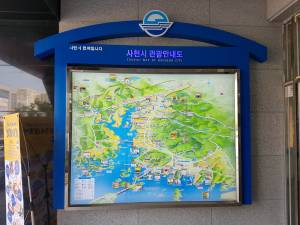 Rather than aircraft in the sky, I had something earthier in mind: dinosaurs. Did you know that Korea’s southern seacoast has more fossilized dinosaur sites than anywhere else in Asia? They are in Haenam, Boseong, Yeosu, Sacheon, Goseong, and the islands of Sado, Chudo, Nangdo, Jeokgeumdo and Mokgeumdo, among other places. These gigantic animals roared, fought and bred during the Mesozoic era (250 million years ago until their extinction 65 million years ago). Kids and adults alike are enthralled with dinosaurs, including Stegosaurus, Tyrannosaurus Rex and my favorite, Triceratops. I had read that the Goseong Dinosaur Museum was close, so I asked a taxi driver to take me there. But when we drove a very long way, I became agitated. From the back seat, I called my girlfriend Audrey and asked her to talk to him. She lied shamelessly and said that Richard was a famous person, so please treat him well. When we finally arrived—I will admit, the 30-kilometer ride was quite scenic—he gave me a discount. The museum, while well done, was almost entirely in Korean. Furthermore, I really wanted to see dinosaur tracks, those huge footprints which are the most tangible proof of their having lived in Korea long before humans arrived. There were none at the museum or in the immediate area. It pained me to realize that I traveled so far and did not see a single dinosaur track.
Rather than aircraft in the sky, I had something earthier in mind: dinosaurs. Did you know that Korea’s southern seacoast has more fossilized dinosaur sites than anywhere else in Asia? They are in Haenam, Boseong, Yeosu, Sacheon, Goseong, and the islands of Sado, Chudo, Nangdo, Jeokgeumdo and Mokgeumdo, among other places. These gigantic animals roared, fought and bred during the Mesozoic era (250 million years ago until their extinction 65 million years ago). Kids and adults alike are enthralled with dinosaurs, including Stegosaurus, Tyrannosaurus Rex and my favorite, Triceratops. I had read that the Goseong Dinosaur Museum was close, so I asked a taxi driver to take me there. But when we drove a very long way, I became agitated. From the back seat, I called my girlfriend Audrey and asked her to talk to him. She lied shamelessly and said that Richard was a famous person, so please treat him well. When we finally arrived—I will admit, the 30-kilometer ride was quite scenic—he gave me a discount. The museum, while well done, was almost entirely in Korean. Furthermore, I really wanted to see dinosaur tracks, those huge footprints which are the most tangible proof of their having lived in Korea long before humans arrived. There were none at the museum or in the immediate area. It pained me to realize that I traveled so far and did not see a single dinosaur track.
A bus took me back to Sacheon, raising the question of why that long and costly taxi ride had been necessary. I found a sikdang (restaurant) close to my hotel and went in for a meal of pork stew. While there, I watched a TV drama set in the Joseon dynasty, maybe 300 years ago. They all seem the same to me—a foreigner still.
The next morning, I checked out and took a south-bound bus to Samcheonpo, a district of Sacheon that used to be a city of its own. The nearby islands of Neukdo and Mado had formed an international maritime trading port during the Iron Age; Koreans, Chinese, Japanese and others did business there. In those same waters on July 8, 1592, Yi Sun-Shin met a Japanese contingent and sank 12 of their ships. Has there ever been a naval commander like the inimitable Mr. Yi?
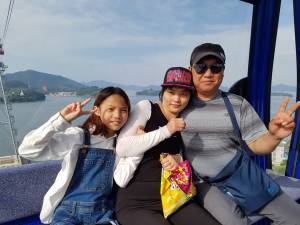 While at Samcheonpo, I took a cable car ride over the strait to the islands where we made a U-turn and came back. From the starting point, we went another two kilometers inland and got off. Those interested and willing, like me, could walk up to the top of the reconstructed Gaksan Tower. A defensive fortification for almost 1,000 years, it provided a splendid 360-degree view. I was accompanied by a man, his wife and 10-year-old daughter. He said they came from Busan. We met by a funny circumstance. While standing in line to buy tickets, the little girl unwrapped some chewing gum, popped the gum into her mouth and put the wrapping paper into the yellow plastic bag I had brought. Her mortified parents apologized profusely.
While at Samcheonpo, I took a cable car ride over the strait to the islands where we made a U-turn and came back. From the starting point, we went another two kilometers inland and got off. Those interested and willing, like me, could walk up to the top of the reconstructed Gaksan Tower. A defensive fortification for almost 1,000 years, it provided a splendid 360-degree view. I was accompanied by a man, his wife and 10-year-old daughter. He said they came from Busan. We met by a funny circumstance. While standing in line to buy tickets, the little girl unwrapped some chewing gum, popped the gum into her mouth and put the wrapping paper into the yellow plastic bag I had brought. Her mortified parents apologized profusely.
The taxi driver who took me back to Samcheonpo Bus Terminal was evidently a sophisticated man because Beethoven’s Symphony No. 9 in D minor, Opus 125, better known as “Ode to Joy,” was playing on his radio.
I had an hour and a half to kill, and the bus terminal was crawling with Uzbeks, Filipinos, Indonesians, Vietnamese, Pakistanis, Nepalese and others (men only, not a single female among them) who toiled in factories in the region. Not far away was the Park Jae-sam Literary Museum, so I went. While I had never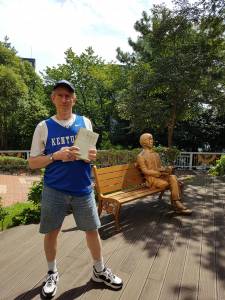 heard of Park, I soon learned that the building, Hoyeonjae, had a history going back to 1770. This is where poets and scholars gathered to write and discuss matters of local, national and cosmic import. Shut down by the colonizing Japanese early in the 20th century, it was rebuilt in 2008. The museum itself celebrates the life and work of Park (1933–1997). According to the Korean Literature Translation Institute, his poetry “expressed the eternal and delicate beauty of nature and the hidden dignity of humble human daily life through the medium of traditional Korean lyrics.” I met the director of the museum and was more than a bit surprised when he gave me a 908-page copy of Park’s collected works.
heard of Park, I soon learned that the building, Hoyeonjae, had a history going back to 1770. This is where poets and scholars gathered to write and discuss matters of local, national and cosmic import. Shut down by the colonizing Japanese early in the 20th century, it was rebuilt in 2008. The museum itself celebrates the life and work of Park (1933–1997). According to the Korean Literature Translation Institute, his poetry “expressed the eternal and delicate beauty of nature and the hidden dignity of humble human daily life through the medium of traditional Korean lyrics.” I met the director of the museum and was more than a bit surprised when he gave me a 908-page copy of Park’s collected works.
By 1 p.m. Sunday, I was in Goseong. Capital of the Gaya Confederacy (42–532 AD), it is today a laid-back town dominated by agricultural and marine businesses, although the dinosaur tracks, dinosaur museum and annual dinosaur festival undoubtedly bring in considerable revenue. A man outside the bus terminal wore a sash, played a wooden Buddhist instrument and chanted; I had to assume it pertained to Chuseok. I was walking toward the central part of the city when I came across a tumulus. Here were buried some royals from at least 1,500 years ago. According to the plaque out front, it had been looted and everything of value taken except some pottery and bronze earrings.
I quickly found lodgings and went straight to the Goseong Museum. The pictures alone told quite a story of how people lived in the past, and the military and political importance of the city, where more than 20 fortresses once stood. I saw stylized depictions of the six main steps involved in building one of 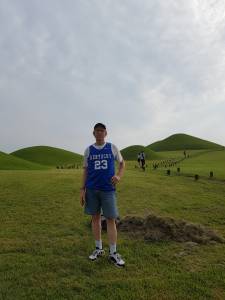 these huge tombs—everything laden with symbolism, of course. Conveniently, the museum stood right next door to an entire field of tumuli. It contained 14, although in some cases more than one person was laid to rest there. The tumuli were at one time the cause of a hot debate among scholars because of a similarity to their Japanese counterparts. Each side wanted to claim primacy.
these huge tombs—everything laden with symbolism, of course. Conveniently, the museum stood right next door to an entire field of tumuli. It contained 14, although in some cases more than one person was laid to rest there. The tumuli were at one time the cause of a hot debate among scholars because of a similarity to their Japanese counterparts. Each side wanted to claim primacy.
About all I did the rest of the day was to cruise the Goseong Fish Market and read my book, a biography of Robert E. Lee.
On to Masan, the third of my three destination cities! I arrived at 10 on Monday morning and got a hotel room just a block from the bus terminal. I would be meeting a friend, Song Woo-jin, at 5. Until then, I wandered around Kyungnam University (17,000 students and 900 faculty members) and down by the water. I saw a marker commemorating the victims of Typhoon Maemi in 2003. It killed 117 people in Korea alone and caused nearly $5 billion in damage.
We all know that Korea was victimized by invading Japanese in the late 16th century and then during the colonial era of 1910–1945. In one instance, though, the tables were turned. The year was 1274, and the Mongols and Koreans (in a 3-to-1 ratio) combined their navies to attempt a takeover of Japan; it failed. I mention this only because their point of departure was Masan.
When Woo-jin—one of my assistants in the drive to convince France to return Jikji—pulled up in his silver Kia, I needed his help. We had to drive to Changwon Bus Terminal so I could buy a ticket back to Seoul on Tuesday morning. As we did, we passed by a long stretch of Masan Bay that was ugly and 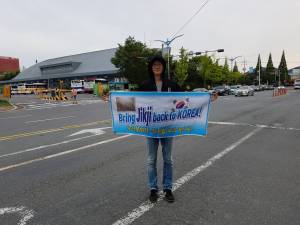 depressing. What must have been for countless generations a beautiful site with beaches and clean water was long since given over to heavy industry, ship building in particular. Everywhere I looked were big, hulking factories. All appeared to be past their prime, and some were empty. Woo-jin informed me about STX, once the fourth-largest ship builder in the world, going bankrupt in 2017, and many suppliers along with it. While significant money had been made there, I could only look at it and moan. After leaving the bus terminal, my friend and I had dinner followed by coffee at Starbucks.
depressing. What must have been for countless generations a beautiful site with beaches and clean water was long since given over to heavy industry, ship building in particular. Everywhere I looked were big, hulking factories. All appeared to be past their prime, and some were empty. Woo-jin informed me about STX, once the fourth-largest ship builder in the world, going bankrupt in 2017, and many suppliers along with it. While significant money had been made there, I could only look at it and moan. After leaving the bus terminal, my friend and I had dinner followed by coffee at Starbucks.
On the bus back to Seoul on Tuesday, there was a television screen. Much of the time, we saw singing-and-dancing performances by young Koreans. Every one, male and female, was wearing a traditional hanbok costume. Only then did I realize how few people I had seen in hanboks during this Chuseok holiday. It is, I fear, another indication of a weakening of Korean traditions.
At the end of this long and exhausting trip, I trudged to the subway and rode the orange line to where it intersected with the green line. When I heard the announcement of Gangnam yuk imnida (“this is Gangnam station”), I felt relieved to be home.

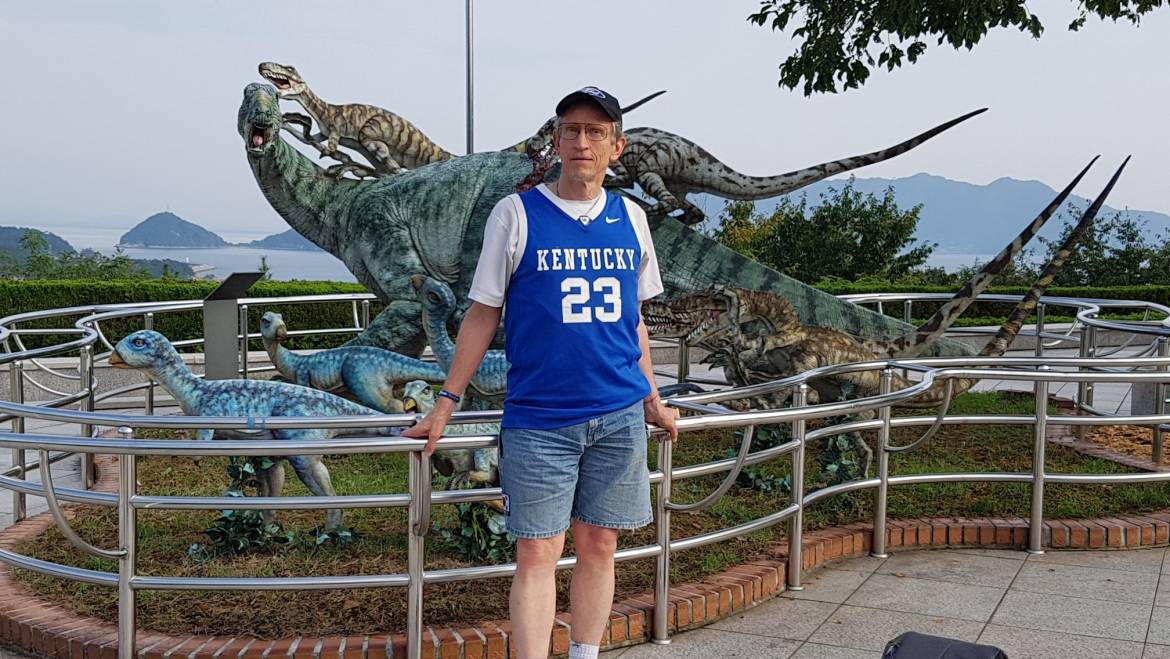
11 Comments
As always, Richard, you have captured the underlying beauty and fascination of other cultures and destinations. I enjoyed “riding along” with you.
Coach, that is just what I try to do–“bring people along” with me. Thanks!
I love dinosaurs, and thought the revelation that so many had been found in Korea was of interest.
The dinosaur tracks at Glen Rose, Texas and in West Texas 20 East of Fort Stockton are the only tracks that I have seen. Very intriguing finds that continuously feed my imagination of prehistoric times and what life was like.
Thanks for sharing your trip and the curiosity that initiated it.
Yes, who doesn’t love dinos???? Glen Rose is famous for it. Thanks for reading and commenting, Mr. Scoggins.
Another fascinating story Richard. For someone who loves outdoors that going to the malls, you brought me into a place that I have never been by reading this. Masan bay part reminds me of what is happening to Manila bay in Roxas blvd. where US embassy is located. So sad that most people nowadays doesn’t care much to mother nature. Thank you for sharing your story.
You prefer outdoors rather than going to the malls? But you like both maybe?? I hate to hear about Roxas Blvd. in Manila being like this….
I always respect your energy and enthusiasm about learning something new! Thank you for sharing your account, and I look forward to the next one 🙂
Well, thanks, Dr. Kim!
That right Dino museum of only one at Asia.
Anyway you have great journey at the traditional holiday, I just knew the trace of a dino only in Goseong city before I read this posting. Wow, it seems that spread out at Southern coast, trace of a dino!
You are great researcher, always:)
hahaha thanks, Ison!
Sounds like it was a great trip and you saw so much! I found it very interesting that you saw foreign working men from all over the world. I didn’t know that was going on in Korea. I guess when you have a strong economy, that happens. Cheers, Kevin
Add Comment